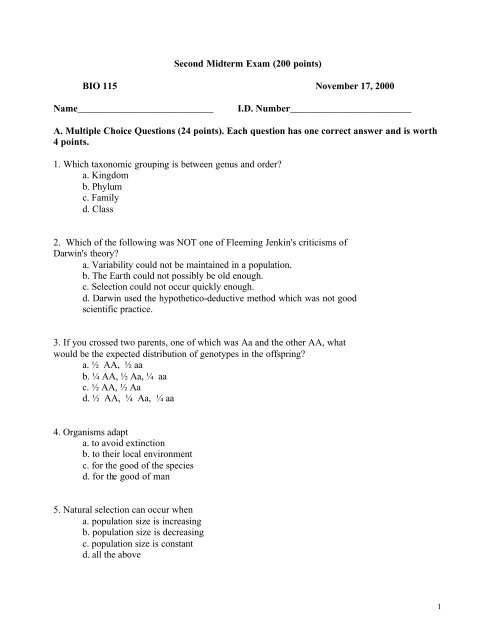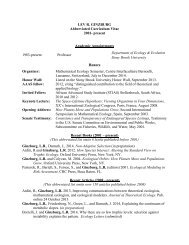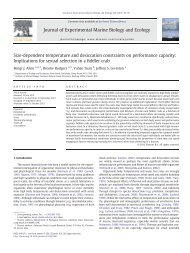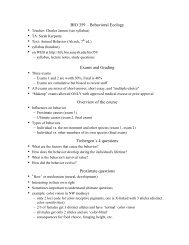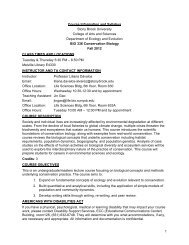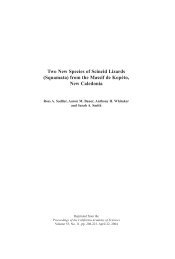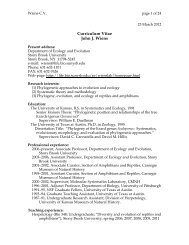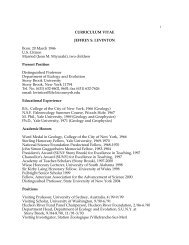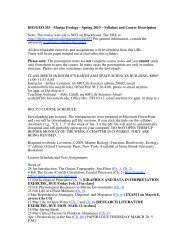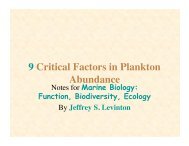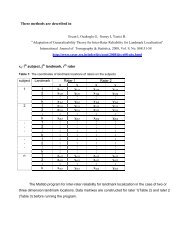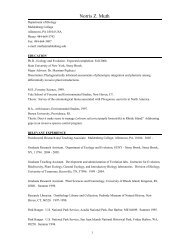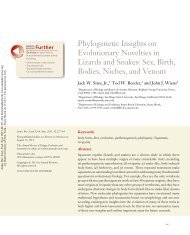Second Midterm Exam (200 points) BIO 115 November 17, 2000 ...
Second Midterm Exam (200 points) BIO 115 November 17, 2000 ...
Second Midterm Exam (200 points) BIO 115 November 17, 2000 ...
Create successful ePaper yourself
Turn your PDF publications into a flip-book with our unique Google optimized e-Paper software.
<strong>Second</strong> <strong>Midterm</strong> <strong>Exam</strong> (<strong>200</strong> <strong>points</strong>)<br />
<strong>BIO</strong> <strong>115</strong> <strong>November</strong> <strong>17</strong>, <strong>200</strong>0<br />
Name____________________________ I.D. Number_________________________<br />
A. Multiple Choice Questions (24 <strong>points</strong>). Each question has one correct answer and is worth<br />
4 <strong>points</strong>.<br />
1. Which taxonomic grouping is between genus and order?<br />
a. Kingdom<br />
b. Phylum<br />
c. Family<br />
d. Class<br />
2. Which of the following was NOT one of Fleeming Jenkin's criticisms of<br />
Darwin's theory?<br />
a. Variability could not be maintained in a population.<br />
b. The Earth could not possibly be old enough.<br />
c. Selection could not occur quickly enough.<br />
d. Darwin used the hypothetico-deductive method which was not good<br />
scientific practice.<br />
3. If you crossed two parents, one of which was Aa and the other AA, what<br />
would be the expected distribution of genotypes in the offspring?<br />
a. ½ AA, ½ aa<br />
b. ¼ AA, ½ Aa, ¼ aa<br />
c. ½ AA, ½ Aa<br />
d. ½ AA, ¼ Aa, ¼ aa<br />
4. Organisms adapt<br />
a. to avoid extinction<br />
b. to their local environment<br />
c. for the good of the species<br />
d. for the good of man<br />
5. Natural selection can occur when<br />
a. population size is increasing<br />
b. population size is decreasing<br />
c. population size is constant<br />
d. all the above<br />
1
6. The Malthusian parameter m from the equation NT = N0emt determines how<br />
populations will change in number through time. If m = 0, then<br />
a. natural selection can not occur<br />
b. there is no reproduction in the population<br />
c. the population will go extinct<br />
d. the population number will stay constant<br />
Section B. Matching: write the letter of the person next to their contribution. (4 <strong>points</strong> per<br />
correct match, 32 <strong>points</strong> total)<br />
1. Charles Lyell 2. Plotinus 3. Sewall Wright 4. Rev. Adam Sedgwick<br />
5. G.F. Gause 6. Thomas Huxley 7. Gregor Johann Mendel<br />
8. Sir Richard Owen<br />
__________________Neo-Platonic thinker who developed the idea of plentitude, which was used<br />
by Lamarck in theory of evolution.<br />
__________________Friend of Darwin, proponent of the theory of uniformitarianism in geology.<br />
__________________Prominent zoologist; Darwin’s “bulldog”, debated with Wilberforce.<br />
__________________His work demonstrated the law of segregation and the law of independent<br />
assortment of genetic material (genes)<br />
__________________American population geneticist; worked in agriculture, and emphasized drift<br />
as an important force changing gene frequencies.<br />
__________________Last important idealist in Britain; showed vertebrate body plants were<br />
homologous.<br />
__________________Criticized Darwin for using the hypothetico-deductive method.<br />
__________________Principle of competitive exclusion; potential vs. actual niche.<br />
2
Section C. Definitions (64 <strong>points</strong>). Define the following terms. (8 <strong>points</strong> each)<br />
1. Batesian vs. Mullerian mimicry<br />
2. scramble vs. interference competition<br />
3. allometry<br />
4. continental drift<br />
5. mutation (definition used by biologist today)<br />
6. natural selection<br />
7. secondary sexual characteristics<br />
3
Section D. Short Answer (4 <strong>points</strong> each, 20 <strong>points</strong> total)<br />
1. Name the four forces that change gene frequency:<br />
1.<br />
2.<br />
3.<br />
4.<br />
2. Mendelian genetics is a _____________ theory of heredity, not a blending<br />
theory.<br />
3. Two causes of mutation are<br />
a.<br />
b.<br />
4. Fleeming Jenkin had four major criticisms of Darwin's theory. Three of<br />
them have been answered by major developments in science. Describe one of<br />
them and name the field of science that arose which provided the answer.<br />
5. According to Ernst Mayr, Charles Darwin made three great contributions<br />
in the Origin of Species. One of these contributions was that he replaced<br />
_____________ thinking by _____________ thinking.<br />
4
Section E. Short Essay. Please answer in the space provided. (15 <strong>points</strong> each, 60 <strong>points</strong> total)<br />
1. Define sexual selection, and give an example of each of the major types<br />
(several were given in class).<br />
2. Describe and differentiate stabilizing, directional and diversifying<br />
selection?<br />
3. The allele A codes for a yellow colored snail shell and the allele a<br />
codes for a blue color. The heterozygotes are green, which means they<br />
blend better with the vegetation and suffer less predation. The fitnesses<br />
are<br />
Genotype AA Aa aa<br />
Fitness 0.25 1.0 0.25<br />
a. What is the equilibrium frequency of allele A? Hint: The equilibrium<br />
frequency of the A allele (p) is p=t/(t+s) where t is the selection against<br />
aa homozygotes and s is the selection against the AA homozygote.<br />
5
. What is the frequency of green snails in the population? (Assume<br />
Hardy-Weinberg proportions). Hint: the frequencies of all the alleles according to Hardy-<br />
Weinberg must add up to 1).<br />
4. Francois Jacob suggests that the metaphor of evolution as a tinkerer is a better one than evolution<br />
as an engineer. What are the reasons he suggests this? Can you think of any ways that the engineer<br />
metaphor may better describe evolution than the tinkerer?<br />
5. Bonus Question (10 <strong>points</strong>): “When you have a recessive allele, it can take a long time to get rid<br />
of it.” Explain this statement and, if possible, illustrate it with equations presented in class.<br />
6


